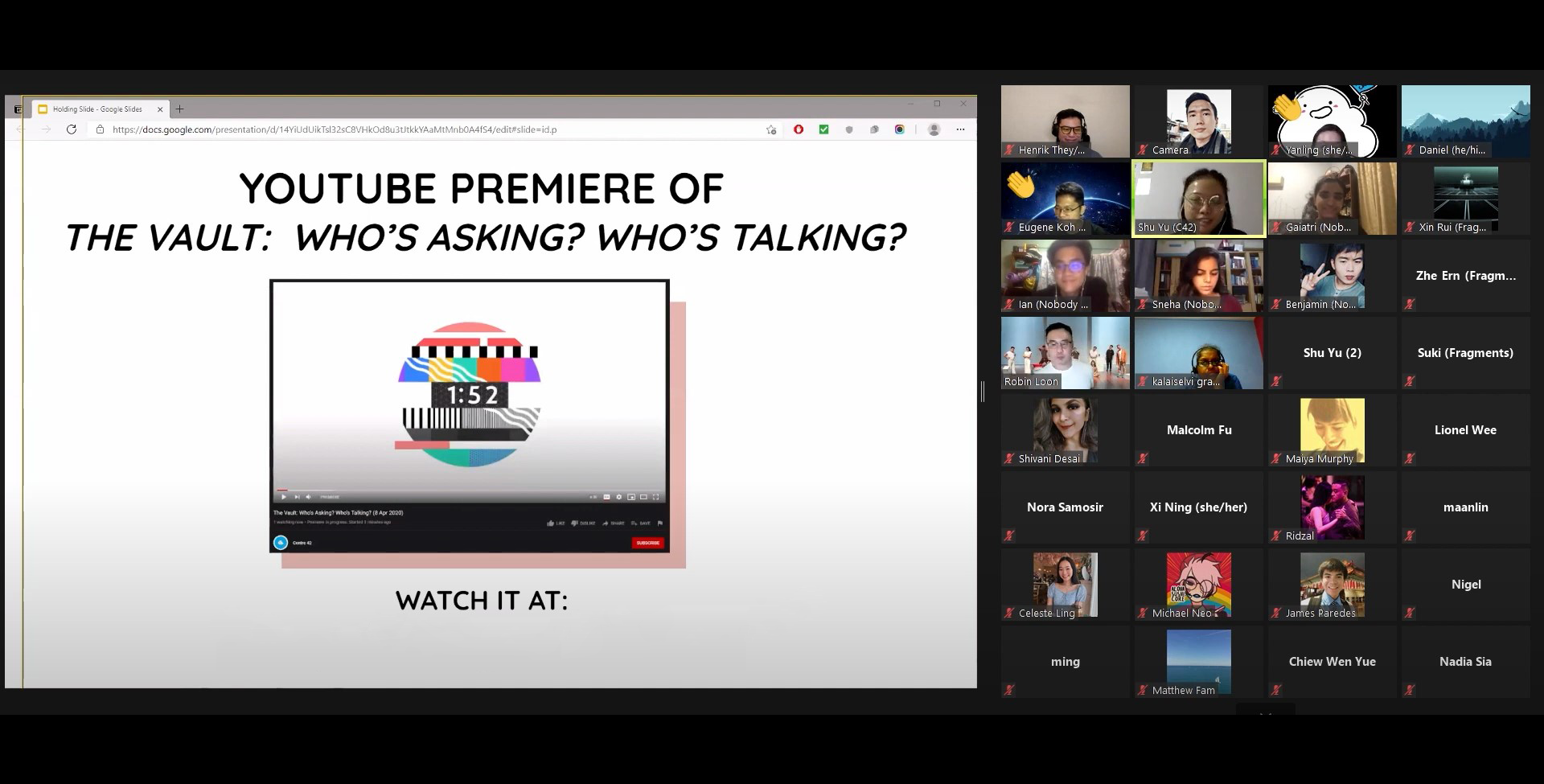Centre 42 held the online premiere and watch party of The Vault: Who’s Asking? Who’s Talking? on 29 April 2021 via Zoom. It featured a double-bill of performance created by the students of the module TS3103 Theatre Lab to respond to the play Madame Mao’s Memories by Henry Ong
The two original works, Fragments and Nobody Asked!, premiered on YouTube live. (See here to view the performance video.) The screening was followed by a discussion segment with the creators of the two works, moderated by the module chair Dr. Robin Loon. Here are some highlights from the sharing segment.
Setting the Scene
Dr. Robin Loon began the segment by explaining the context of the Vault. He shared that the response element as a pedagogy was something he devised with Centre 42 for The Vault programme some years ago. It is “a way of documenting Singapore theatre with a way of creative reimagining or reengagement with the text”.
In the 13-week process, students underwent a series of physical workshops to awaken and engage the body, one of which was conducted by practitioner Lian Sutton. They had also attended a documentation workshop with Daniel from Centre 42, to guide them with the auto-ethnographic and peer-documentation elements of the module. They also embarked on research and made pitches across several key themes of Madame Mao’s Memories, such as gender, theatre and history, before formulating a performance response.
Impetus for the Responses
Nobody Asked! shared that they began with a visceral response to Madame Mao’s Memories: frustration that Henry Ong, a male Asian-American playwright felt justified in telling the story of a Chinese woman. The group thought he painted the life of Jiang Qing, or Madame Mao, in an “unfair” light.
They decided to devise a post-dramatic expression rich in sound design, choreography and vignettes to convey the frustration, as well as the attendant theme of female oppression.
Fragments took an interest in the foreword of the play, in which they learnt Ong had a “self-confessed lack of knowledge regarding the culture and the language” of the play.
In writing the individual journey of Jiang Qing, they realised he left out the amount of collateral damage the cultural revolution had wrecked on the people of China. As such, they wanted to “restore some degree of historical context” to the play as a response. To do so, they wanted to be self-reflexive in the work and acknowledge their own identity members of the Chinese diaspora, in order to caveat their disconnect from the subject matter. Xin Rui from Fragments shares one of the considerations was the question, “Whose truth are we presenting exactly?”.
Response and Commentary
One audience member wondered why the groups chose to engage with authorship and Ong’s identity rather than with the content of the play per se.
Gaiatri from Nobody Asked! shared that she was keen to interrogate the act of writing itself, and felt “personally affronted” by the distant positionality of the playwright. Her groupmate Sneha added that Jiang Qing is a real figure and so, one “cannot divorce a body from their story.”
Fragments shared they did use content from both history and the play to reimagine and offer healing around the Cultural Revolution. After the documentation workshop, the team realised the playwright had created a text in which he too was inevitably implicated.
Dr Robin Loon said of the approaches, “I’m always very surprised at what students choose to respond to in the plays assigned. I feel it’s a unique part of this module, that there is no set way to do it. Students will see certain meaningful things that they want to see and it’s what groups have to negotiated amongst themselves.”
Performance and Vocabulary
Both groups also investigated creating performance vocabulary to support what they wanted to convey.
For instance, Nobody Asked! shared they employed a selection of references to memes and contemporary issues as a strategy to evoke particular feelings of familiarity and frustration in the audience, and also to provoke introspection.
They also deliberately redacted the context of one of their key characters, Woman X, allowing her to escape the failings of the author and audience. An audience member shared that they found it hard to connect with the characters of Nobody Asked! with little information, to which the creators remarked that the ambiguity was precisely to further elude characters beyond simple definition.
Fragments relied on two conventions: Butoh and puppetry.
In order to restore some historicity to Madame Mao’s Memories, they employed Butoh to communicate the pain and anguish brought about by the Cultural Revolution. Embodiment was important to their investigation of intergenerational trauma, so choosing an appropriate form like Butoh to evoke those physical sensations and stark visuals was necessary.
Ci Xuan mentioned they used their massive puppet to do what the human body cannot, such as represent violence. It also communicated otherness, a metaphor for their relationship to and distance from the difficult subject matter. “We’re talking about something that is not like us. Our interactions with (the puppet) were clumsy and awkward; (it expresses that) we’re still trying to grapple with it,” she adds.
Learnings
For many, The Vault: Who’s Asking? Who’s Talking was the first time they were devising an original work. Gaiatri shared that group synergy was important. Where differences in thinking occurred, it made for more robust creative discussions, but it also meant learning to be clear and effective communicators.
Zhe Ern from Fragments reflected that one of her most crucial takeaways was on finding a voice and having something to say. “What do we take into consideration when we want to put something out?” she summarised.
By Lee Shu Yu
Published on 25 May 2021

